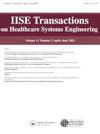精神分裂症基于密度的图分类(Louvain dbGC)中的Louvain聚类集成
IF 1.5
Q3 HEALTH CARE SCIENCES & SERVICES
IISE Transactions on Healthcare Systems Engineering
Pub Date : 2021-06-07
DOI:10.1080/24725579.2021.1933268
引用次数: 1
摘要
摘要几种大脑疾病的特点是其无声的表现,不表现出临床症状,通常在大脑疾病可能不可逆转的晚期被诊断出来。诊断某些大脑疾病的常见策略取决于自我报告的症状和长期观察到的行为,而且没有定量测试来诊断精神疾病。精神障碍是美国残疾的主要原因,其特征通常是行为变化,而没有明显的大脑疾病(如肿瘤引起的疾病)中常见的结构变化迹象。随着新的诊断方法的出现,越来越多的人被诊断出患有精神障碍,一些研究表明,早期检测对改善患者预后对恢复大脑功能的重要性。因此,本研究的目标是确定生物标志物和潜在的生物底物,从而对精神分裂症患者进行早期诊断和改进治疗。我们将聚类技术和基于密度的图分类相结合,以更好地预测精神分裂症患者的异常功能网络。Louvain dbGC将局部和全局图形测量与大脑网络的中尺度组织相结合。为了评估Louvain dbGC的有效性,应用了多种特征选择和分类算法。与(1)基于种子的分析、(2)独立分量分析和(3)WUD图分析的最新方法进行了比较。Louvain-dbGC以99.3%的准确率、98.80%的灵敏度和100%的特异性更好地将精神分裂症与健康对照进行分类和分离。Louvain dbGC可以扩展到其他精神障碍,以检测和监测此类疾病的治疗干预措施。本文章由计算机程序翻译,如有差异,请以英文原文为准。
Louvain clustering integration within density-based graph classification (Louvain dbGC) in Schizophrenia
Abstract Several brain disorders are characterized by their silent manifestations that do not display clinical symptoms and are usually diagnosed at advanced stages in which the brain disease may be irreversible. Common strategies to diagnose some brain disorders depend on self-reported symptoms and observed behavior during an extended period of time, and there are no quantitative tests to diagnose mental disorders. Mental disorders are the leading cause of disability in the US and are typically characterized by behavioral changes without clear signs of the structural changes often seen in brain diseases, such as those caused by tumors. With new diagnosis methods, more people are being diagnosed with mental disorders, and some research suggests the importance of early detection to improve patients’ prognoses in restoring the functionality of the brain. Therefore, the goal of this study is to identify biomarkers and underlying biological substrates that will lead to early diagnosis and improved treatment for schizophrenic patients. We combined clustering techniques and density-based graph classification to better predict abnormal functional networks in schizophrenics. The Louvain dbGC combines local and global graph measures with the mesoscale organization of brain networks. To evaluate the effectiveness of the Louvain dbGC, multiple feature selection and classification algorithms were applied. Comparison with state-of-the-art methods of (1) Seed-based Analysis, (2) Independent Component Analysis, and (3) WUD Graph analysis is conducted. The Louvain dbGC better classified and separated Schizophrenics from Healthy Controls with 99.3% accuracy, 98.80% sensitivity, and 100% specificity. The Louvain dbGC can be extended to other mental disorders to detect and monitor therapeutic interventions of such diseases.
求助全文
通过发布文献求助,成功后即可免费获取论文全文。
去求助
来源期刊

IISE Transactions on Healthcare Systems Engineering
Social Sciences-Safety Research
CiteScore
3.10
自引率
0.00%
发文量
19
期刊介绍:
IISE Transactions on Healthcare Systems Engineering aims to foster the healthcare systems community by publishing high quality papers that have a strong methodological focus and direct applicability to healthcare systems. Published quarterly, the journal supports research that explores: · Healthcare Operations Management · Medical Decision Making · Socio-Technical Systems Analysis related to healthcare · Quality Engineering · Healthcare Informatics · Healthcare Policy We are looking forward to accepting submissions that document the development and use of industrial and systems engineering tools and techniques including: · Healthcare operations research · Healthcare statistics · Healthcare information systems · Healthcare work measurement · Human factors/ergonomics applied to healthcare systems Research that explores the integration of these tools and techniques with those from other engineering and medical disciplines are also featured. We encourage the submission of clinical notes, or practice notes, to show the impact of contributions that will be published. We also encourage authors to collect an impact statement from their clinical partners to show the impact of research in the clinical practices.
 求助内容:
求助内容: 应助结果提醒方式:
应助结果提醒方式:


